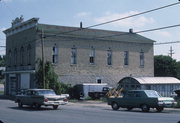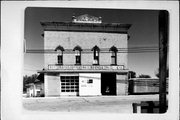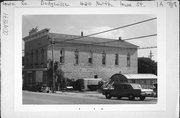| Additional Information: | A 'site file' exists for this property. It contains additional information such as correspondence, newspaper clippings, or historical information. It is a public record and may be viewed in person at the Wisconsin Historical Society, State Historic Preservation Office.
This two-story commercial vernacular styled opera house features a rectangular shaped plan configuration, a limestone foundation, and a gable roof. The first story, which was built in 1840, has exterior walls made of limestone rubble, while the upper story, which was built forty-two years later in 1882, has exterior walls made of brick. (See Bib. Ref. A). Distinguishing the facade is a denticulated and bracketed metal cornice. Above it is a partial pedimented parapet, with the name of the building inscribed on it. Round arched openings on the facade and segmental arched openings on the side elevation characterize the windows on the second story. The first floor facade has been substantially altered from its original appearance. The structure is in fair condition.
This property is not part of the Iowa Street Historic District.
Historical Background:
The first floor of Spang's Opera House was constructed in 1840 by brothers Oliver and Peter Wise, who used the stone building as a blacksmith shop. William Cornish and Jonathon Dickerson were subsequent owners, followed by Peter Spang, a blacksmith who rented the building in 1872 and purchased it a year later. Spang (his residence is located at 201 E. Walnut Street, 45/35) employed six to eight men in his shop and operated the only power cider-mill in the vicinity. (See Bib. Ref. A, C).
In 1882, Spang added the second story to his building and opened the Opera House to accommodate the cultural and social needs of Dodgeville's growing population. (See Bib. Ref. A). Plays such as "Uncle tom's Cabin," an audience favorite, concers, comedy acts, and even basketball games were featured at the popular facility, which by the early twentieth century, was the location of the city's first movie theater. Shown on a sheet instead of a screen, the early films shown at Spang's were often sponsored by sellers of northern Wisconsin lands. (See Bib. Ref. D).
By the second decade of the twentieth century, Spang's was superseded by the Auditorium (130 N. Iowa Street, 44/8), which had ample room to accommodate a variety of events and activities and the Crystal Theatre, a movie theatre located in the Hocking Block (no longer standing).
In the following years the lower level of the Opera House housed the car dealership and repair service of brothers Fred and Pat Woerpel (this business later moved to the Woerpel Building, 205 N. Iowa Street, 47/9) and a creamery (1927). (See Bib. Ref. D, E). The second floor hall was still open during this period and, in fact, until 1939 all high school basketball games were played there. (See Bib. Ref. F).
Historical Significance:
Spang's Opera House, a prominent feature of N. Main Street, Dodgeville's original commercial thoroughfare, is historically significant for its association with the cultural and social development of the lead mining center. From 1882 to c. 1910, the large brick and stone structure housed dramatic productions and comedy acts, concerts, community dances, athletic events, and the city's first movie theater. |
|---|
| Bibliographic References: | A. "Dodgeville Chronicle," 28 October 1954.
B. "Spang('s) Opera House": On building.
C. "History of Iowa County, Wisconsin," (Chicago: Western Historical Co., 1881), pp. 745, 759.
D. Scrapbook, "Along Main Street," "Dodgeville Chronicle" articles, 1933, Iowa County Historical Society.
E. 1915, 1927 Sanborn Perris Maps.
F. Mr. and Mrs. Ken Fox, Manuscript compiled from various sources, Iowa County Historical Society.
G. Walking Tour of Historic Dodgeville, Wisconsin, Dodgeville Historic Preservation Commission, 1995.
Dodgeville Chronicle 7/10/1997.
Gays Mills Crawford County Independent and the Kickapoo Scout 7/3/1997.
Dodgeville Chronicle 6/12/1997. |
|---|



